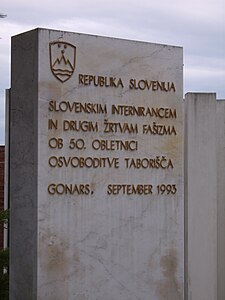Gonars concentration camp
| Gonars | |
|---|---|
| Italian concentration camp | |
 Monument for Slovene victims | |
| Location | Gonars, Kingdom of Italy |
| Operated by | Italian Ministry of the Interior |
| Commandant | Lieutenant Colonel Eugenio Vicedomini, Cesare Marioni, Ignazio Fragapane, Gustavo De Dominicis, Arturo Macchi[1] |
| Operational | 23 February 1942 – 8 September 1943 |
| Inmates | Mostly ethnic Slovenes and Croats |
| Number of inmates | 10,000[2] (1943) |
| Killed | 500+ |
The Gonars concentration camp was one of the several Italian concentration camps and it was established on February 23, 1942, near Gonars, Italy.
Many internees were transferred to this camp from the other Italian concentration camp, Rab concentration camp, which served as equivalent of final solution in Mario Roatta's ethnic cleansing policy against ethnic Slovenes from the Italian-occupied Province of Ljubljana and Croats from Gorski Kotar, in accord with the racist 1920s speech by Benito Mussolini, along with other Italian war crimes committed on the Italian-occupied territories of Yugoslavia:
When dealing with such a race as Slavic – inferior and barbarian – we must not pursue the carrot, but the stick policy.... We should not be afraid of new victims.... The Italian border should run across the Brenner Pass, Monte Nevoso and the Dinaric Alps.... I would say we can easily sacrifice 500,000 barbaric Slavs for 50,000 Italians....
The first transport of 5,343 internees (1,643 of whom were children) arrived two days after its establishment, on February 23, 1942, from the Province of Ljubljana and from the other two Italian concentration camps, the Rab camp and the camp in Monigo (near Treviso).
The camp was disbanded on September 8, 1943, immediately after the Italian armistice. Every effort was made to erase any evidence of this black spot of Italian history. The camp's buildings were destroyed, the materials were used to build a nearby kindergarten and the site was turned into a meadow.[citation needed]
Only in 1973 a sacrarium was created by sculptor Miodrag Živković at the town's cemetery. Remains of 453 Slovenian and Croatian victims were transferred into its two underground crypts. It is believed that at least 50 additional persons died in the camp due to starvation and torture. Apart from the sacrarium no other evidence of the camp remains and even many locals are unaware of it.[citation needed]
Slovene notable inmates
- Viktor Antolin, professor of philosophy (student/journalist at the time)
- France Balantič, poet
- France Bučar, lawyer, writer, and statesman in post-1991 Slovenia
- Lojze Bukovac, bearer of Commemorative Medal of the Partisans of 1941, a writer
- Alojz Gradnik, poet
- Bogo Grafenauer, historian
- Zora Konjajev, pediatrician
- Boris Kraigher, politician
- Vasilij Melik, historian
- Frane Milčinski (pen name Ježek), a poet, actor, children's writer, and director
- Jakob Savinšek, sculptor and poet
- Bojan Štih, literary critic, essayist, and stage director
- Bogdana Stritar, opera singer
- Nada Vidmar, opera singer
- Nande Vidmar, painter
- Anton Vratuša, politician
- Aleš Strojnik, scientist and educator
- Vitomil Zupan, writer
Sources
- Alessandra Kersevan (2008): Lager italiani. Pulizia etnica e campi di concentramento fascisti per civili jugoslavi 1941–1943. Editore Nutrimenti,
- Alessandra Kersevan (2003): Un campo di concentramento fascista. Gonars 1942–1943., Kappa Vu Edizioni, Udine.
- Nadja Pahor Verri (1996): Oltre il filo : storia del campo di internamento di Gonars, 1941–1943, Arti Grafiche Friulane, Udine.
- Luca Baldissara, Paolo Pezzino (2004): Crimini e memorie di guerra: violenze contro le popolazioni e politiche del ricordo, L'Ancora del Mediterraneo. ISBN 978-88-8325-135-1
Further reading
- Bregar, Ana (2013): Comparing situation at the Gonars Concentration Camp and the Rab Concentration Camp (In Slovene: "Primerjava taboriščnih razmer na Rabu in v Gonarsu"), Diploma thesis, Faculty of Arts, Department of history, University of Ljubljana.
- Megla, Maja (2012): Dr. Peter Starič, inženir elektronike, o svoji novi knjigi, ki izide septembra v angleškem jeziku, Delo.
- Mihajlovič, Nataša (2012): Comparing the Gonars Concentration Camp and the Mauthausen Concentration Camp (In Slovene: "Primerjava koncentracijskih taborišč Gonars in Mauthausen"), Diploma thesis, Faculty of Arts, Department of history, University of Ljubljana.
- Škorjanec, Viljenka (2011): Italijanske metode pri izpustu iz koncentracijskih taborišč, Zveza zgodovinskih društev Slovenije, Ljubljana, Zgodovinski časopis, 1–2, pp 152–171
In popular culture
- Toffolo, Davide (2010): L'inverno d'Italia (In English: "Italian winter", translated in Slovene under the title "Italijanska zima",[6] a graphic novel about two children interned at Gonars), Coconino Press.
- Minigutti, Dorino (2009): Beyond the wire (In Slovene: "Onstran žice"), a documentary film, Gorizia.[7]
See also
References
- ^ "Gonars Concentration Camp". Retrieved 21 June 2022.
- ^ Herman Janež: Onstran žice – Gonars (2): Prihodi transportov s taborišniki (deutsch: Jenseits des Zaunes – Gonars (2): Die Ankunft der Gefangenentransporte), mehrteilige Reihe in der slowenischen Wochenzeitung Dolenjski list, Novo mesto, 9. August 2012, S. 18.
- ^ Pirjevec, Jože (2008). "The Strategy of the Occupiers". Resistance, Suffering, Hope: The Slovene Partisan Movement 1941–1945 (PDF). p. 27. ISBN 978-961-6681-02-5.
- ^ Verginella, Marta (2011). "Antislavizmo, rassizmo di frontiera?". Aut aut (in Italian). ISBN 978-88-6576-106-9.
- ^ Santarelli, Enzo (1979). Scritti politici: di Benito Mussolini; Introduzione e cura di Enzo Santarelli (in Italian). p. 196.
- ^ Petejan, Saša (2011) Otroci in vojna: Internacija je mnogo več kot le politična dediščina, Dnevnik, Ljubljana
- ^ Spomini internirancev v Gonarsu, Primorski dnevnik, 2012, Trieste.
